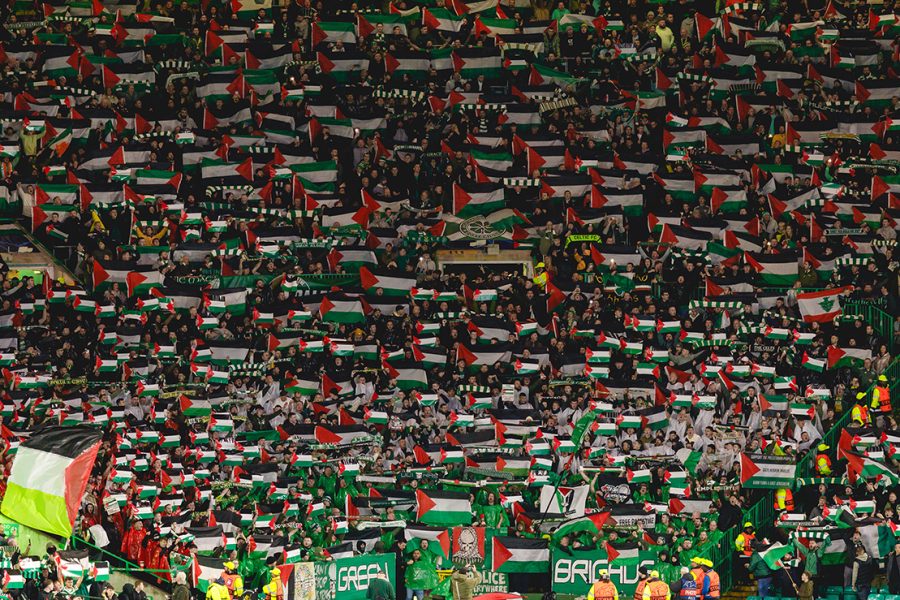During the summer, a member of the Green Brigade spent some time in Palestine. The following is an interview they completed with a German fanzine following their return to Scotland. The interview took place before the recent genocide in Gaza (currently ongoing) and tightening of the occupation of the West Bank. Therefore, some of the language used and/or sentiment expressed does not reflect these recent events.
J:
We want to delve deeper into the issue by showing how the Middle East conflict affects millions of Palestinians. With this in mind, we invited X to tell us more about Celtic supporters’ involvement in a special project called Aida Celtic. In addition, X recently visited Palestine, and we hope he can give us some first-hand insights. X, thanks for joining us.
X:
Thanks for having me, but more importantly, thank you and well done for your recent action in solidarity with Jenin. It’s great to see more people in more and different spaces taking notice of the situation in Palestine. That’s particularly important in Germany, where there seems to be a reluctance or discomfort with criticising Israel or supporting Palestine. So your action took courage, and I hope it helps form a conversation and critical thinking, be that locally or wider.
Before I go any further, I want to qualify my words by making it clear I am not an expert on the situation in Palestine. I’m just someone who developed an interest, which became a passion, who has tried to understand and learn as much as possible. I encourage all readers to do likewise, from as many sources as possible, but especially from those who live through it; and the best education is going and experiencing it.
J:
Celtic supporters are known for their left-wing attitudes and references to the struggle either in Ireland or Palestine. Can you give us some insight into why Celtic supporters show solidarity with the Palestinian people?
X:
There’s potentially a few different strands to it; however, I’d say the main reason is it is an extension of the international solidarity between the Irish Republican and Palestine liberation movements. Most young Celtic fans learn about the history of our club, which inevitably crosses over into the Irish struggle. When learning about the Irish struggle, you become aware of other movements, be they similar in cause, ideology, or challenges. The Irish and Palestinian causes share many similarities, and as a result, there is a great connection and solidarity between both peoples and movements.
I suppose on a more general and less political level, you could say that the values of our club and the story of our formation lend our supporters to be more inclusive, tolerant, and supportive of other people and communities who face hardships. So on a wider level, you would find most Celtic fans are at least sympathetic towards Palestine. However, I’d argue that the people who first started taking Palestine flags to Celtic matches – before the Green Brigade – were influenced by Irish republicanism, and that’s also true of the Green Brigade who later picked up the torch.
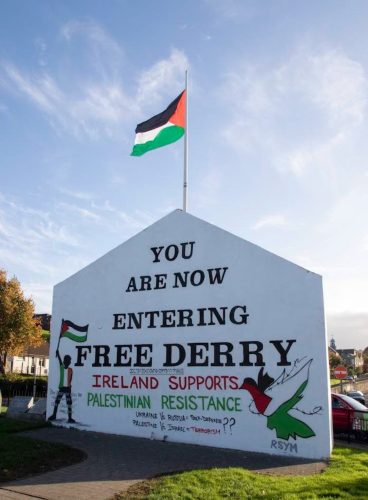
J:
What is Aida Celtic, and how has it evolved?
X:
Aida Celtic is a football academy based in Aida Refugee Camp in Bethlehem, Palestine. It is run locally by the Lajee Center within the camp and supported internationally by the Green Brigade. The Lajee Center is a grassroots community centre which works with all generations of people on an extensive list of programmes like sports, health, environment, arts, human rights, etc. The Green Brigade has been working with the Lajee Center since 2010.
The Aida Celtic idea arose following the match between Celtic and Hapoel Be’er Sheva in 2016. At the match, the Green Brigade displayed hundreds of Palestine flags in a show of solidarity. As a result, UEFA charged Celtic for its fans showing an “illicit banner.” In response, the Green Brigade launched a fundraising campaign called ‘Match the Fine for Palestine.’ The campaign was designed mainly to challenge UEFA’s own racism towards Palestine and further our message of solidarity. At the time, we didn’t expect to raise the amount of money that we did. Celtic was eventually fined £8,600 by UEFA, while ‘Match the Fine’ raised £176,076. The money was split between two charities: the Lajee Center; and Medical Aid for Palestinians.
The campaign and global exposure became so significant that we wanted to create a lasting legacy; something to cement and sustain the relationship between Celtic and Palestine for years to come. That legacy was Aida Celtic. Aida Celtic was officially launched in 2019 as one kids team and one adult team. Although to many of our international followers, it may appear that the club has been pretty quiet, there’s been a lot of progress on the ground in terms of building the infrastructure of the club and building its profile locally. This is despite facing local challenges with the bureaucracy of the Palestine footballing authority, which has prevented our teams from taking part in competitive tournaments…but that is due to change very soon.
Now, our academy has two age groups with 80 kids registered. Our popularity continues to grow, and it is the only academy of its kind in Bethlehem. The first team will eventually have a squad of around 20 players, although this is still to be finalised ahead of the next footballing season. The next football season presents the next, exciting chapter in our story as we enter the professional Palestinian football league. Each first team player will be contracted to the club, receiving a modest fee, and should they wish to move to another club within the season, then the club will be due a fee from their new club for the player’s registration to transfer.
Significantly, the club has now evolved to represent the three refugee camps within Bethlehem (Aida, Al Azza, and Dheisheh) as well as the wider Bethlehem area. We have plans in place to reflect the growth of the project as we enter the next chapter of our story.
[Given recent events in Palestine, these plans have been put on hold as there are more pressing concerns and challenges.]
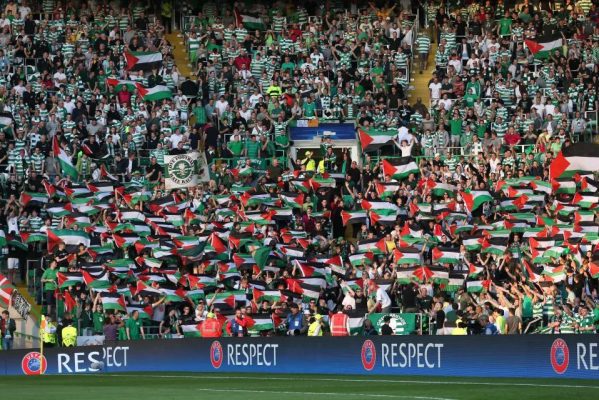
J:
What are the major objectives of your ongoing work in the context of Aida Celtic?
X:
The objective from the beginning was humble – to provide an outlet within Aida Refugee Camp for children and adults to play football. That meant having a properly financed and facilitated football setup where those involved would not need to contribute financially. The idea was to lean on the Celtic support and the global Palestine solidarity movement – the exact same people who contributed to ‘Match the Fine’ and inspired the formation of the club.
To do this, we have sold the football shirts which the teams wear. To date we have produced two shirts, each heavily influenced by Celtic and Palestine, therefore appealing to the two groups of people we rely on to sustain the project. The last shirt was inspired by the Scottish rock band Primal Scream, who are also big Celtic and Palestine supporters. Not only did they finance the shirt, but they brought massive exposure to the project, including Eric Cantona, which saw an even bigger spike in interest!
The original objective remains the same, although we are now covering beyond Aida Camp. With the growth of the infrastructure and reputation, there is more ambition now for developing young footballers, retaining and attracting talent, and ultimately having successful teams. While the club enjoys impressive international backing, to build its profile and reputation within Palestine, success on the field will be key.
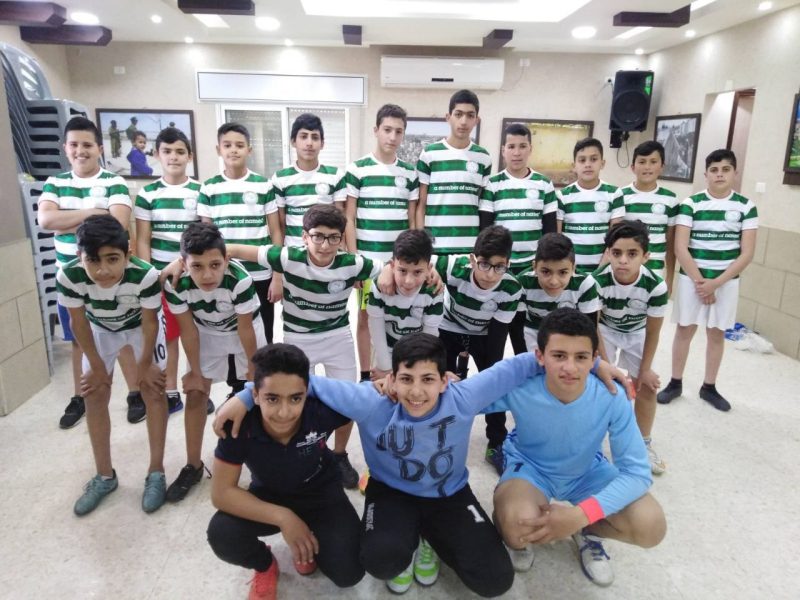
J:
What are the perspectives of Aida Celtic in the face of an ongoing and likely unresolvable conflict?
X:
The most obvious perspective is that of an illegal military occupation. Included in that is the apartheid wall which casts its ugly shadow over the small football pitch which is home to Aida Celtic. There is no escaping the occupation in Palestine; it is an every day, visible, and tangible reality for all Palestinians.
A coach of Aida Celtic is currently in an Israeli prison under administrative detention – imprisoned without charge or trial. Each of the 80 kids in our academy will have family members who have been imprisoned or murdered by the Occupation Forces. Some of the older kids will have been arrested, interrogated, and tortured themselves – all of them most likely will be at some point. For the adult first team, each of them will have already been through those ordeals and will likely do so again. Every single Palestinian, of all ages, lives with and endures the constant trauma of their environment and experiences. All of this has an effect on the activities and perspectives of the club.
If we try to focus on the sporting side, then the sporting infrastructure is weak and unreliable just like the entire infrastructure of Palestinian society. Every single aspect of Palestinian life is under the stranglehold of the Occupation and has been for over 75 years. That in itself makes the everyday struggle to survive, and live, and defy, and resist all the more impressive. Be it through arms, boycott, culture, or sport – there are various strands of resistance and organisations like Aida Celtic have a role to play in providing outlets for people to keep resisting and keep living as normal a life as possible.
The most impressive thing about Palestinians is their spirit. Despite the odds, they continue to live. We want Aida Celtic to have that same spirit: to continue to grow and be successful; to be a beacon of pride for Palestinians; and be a symbol of resistance and solidarity.
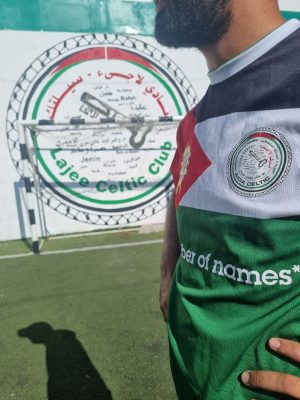
J:
Let’s talk a little more about your personal experiences. How many times have you been to Palestine, and what are your reasons for returning to Palestine so often?
X:
I have been to Palestine three times, although I’ve also been to Lebanon and Jordan where I spent time in Palestinian refugee camps. One thing people often don’t realise about the Palestinian population is that they have been very deliberately fragmented. Each fragment has its perspective and challenges, which are different from the next. It’s a classic divide and conquer tactic.
From a young age, I was interested in Palestine, again due to the links with Ireland, which I have already covered. On a more personal level, my interest was spiked in 2008 during an Israeli assault on Gaza. I remember watching the news coverage on the BBC and then flicking over to Al Jazeera; then to Sky News and then to Press TV. The stark contrast in the reporting triggered something in me, and from there I began to educate myself on the situation.
I’ve done a fair bit of traveling, but nothing compares to Palestine. There is an emotion and reality about the place that strikes you and never leaves you. The people are the most inspiring I’ve ever experienced. Their hospitality is second to none. The ancient history is interesting. The scenery is beautiful. The food is amazing. The culture is so rich and historic. All of this in the face of brutal oppression and ethnic cleansing. It’s remarkable that the people find the strength to keep enduring in the face of this.
My most recent trip coincided with the Lajee Center’s international summer camp for adults, where they invite internationals to volunteer in the camp as part of a two-week educational and cultural programme. The main purpose of my visit was to see friends, work on the Aida Celtic project, and coach boxing – but I was lucky enough to participate in most of this programme too. For anyone interested, I would thoroughly recommend that you check out this annual programme – it’s an experience and education of a lifetime.
J:
In August, you visited some of the areas probably most affected in the West Bank — Nablus and Jenin. Could you try to convey what you experienced there?
X:
I will try… First you need to understand the challenges in even getting to either city. Bethlehem, where I was based, is only 50 miles from Nablus. However under the apartheid regime, there is only one road that Palestinians can use to travel the length of the West Bank. Despite the West Bank being defined as Palestinian territory under international law, it has been under military occupation for over 75 years and has at least 140 Israeli colonies not including outposts (which will develop into colonies). The road is littered with Occupation checkpoints. It is your luck whether the checkpoint is open, or how long it will take you to pass through, many times dependent on the mood of the soldiers at the time. Congestion is common, at any hour, as there is only one road people can take.
Driving along the road is a stark insight into apartheid. The Palestinian road is in poor condition. Every so often you will see a sign proclaiming ‘US Aid helps maintain the road’ – what that really means is the US maintains the apartheid system. The road is littered with Occupation Forces, their presence increasing whenever Israeli roads converge or there is a colony nearby. Colonies are often on the hills, standing out like sore thumbs as the buildings are fresh and modern. Aside from that, the most notable visible difference between an Israeli colony and a Palestinian neighbourhood is water tanks. All Palestinian buildings have water tanks on their roof as they have a restricted supply of water – unlike Israelis. On occasion, as you pass a colony, the Palestinian and Israeli roads converge meaning the Palestinians enjoy a few hundred metres of smooth road, before they split in different directions and it’s back to the rocky road to Nablus.
Nablus is home to the most densely populated refugee camp in the West Bank – Balata. At 0.25 sq km, it has a population of over 32,000 people. In Balata I visited the Yaffa Center – in my experience every refugee camp has very similar organisations which offer vital services to their community. Here I met with health workers who spoke about their work in the community. The emotion was raw, some people in the room being brought to tears. Last year I had a short tour through Balata, this time it wasn’t allowed due to security reasons.
Nablus is a hotbed for armed resistance and in most cities/towns the armed resistance is strongest within the refugee camps. However, the old city of Nablus (the city centre) is slightly different and also has a proud reputation of armed resistance. It is here where Arin Al Usud (The Lions Den or Den of Lions) rapidly came to popular acclaim in 2022, sparking a new wave of Palestinian armed resistance in the West Bank. They were a small group of young men who had grown frustrated by inefficient Palestinian political parties and their affiliated armed wings. They started fighting back against the Occupation free from any hierarchical command, documenting their efforts on social media and messaging apps. They staged parades in the old city where they adopted a different look to traditional fighters – dressed all in black, with black bucket hats and red ribbons attached to the end of their guns. It had a deliberately romantic feel, similar to a TV show like Casa de Papel that leans on revolutionary romance and symbology. They captured the hearts of the Palestinian population.
Most of these young men are now dead, some in prison. Israel recognised their threat and wiped them out before they could realise their potential. Posters, plaques and banners of martyrs from all factions adorn every wall of the old city. The people are clearly proud of their sacrifice and support the generation who continue the armed struggle. My guide through the city knew the person behind every poster. He gave insight into the tactics of the armed resistance, himself a fighter during the second intifada. He told me that the people live vicariously through their fighters who protect their neighbourhoods and people, challenge the Occupation and keep the flame of resistance burning.
Jenin is the heart of the armed resistance (in the West Bank). As a result, the city and its refugee camp has faced some of the worst Israeli aggression. A month prior to my visit saw an invasion and massacre of Jenin Camp which was the worst since a similar invasion in 2002. Entering the camp, I was struck by the destruction – buildings brought to rubble, roads with craters, cars and other things burnt to a crisp. Quickly after entering, the armed resistance stopped our small mini bus to check who we were. Jenin Camp doesn’t get many international visitors. It’s not unusual for the Occupation Special Forces to infiltrate Palestinian neighbourhoods disguised as tourists, paramedics or even as Muslim women in full traditional, religious dress therefore security around camps like this is always tight. We were expected so there were no issues – we continued into the camp to our destination with some fighters shadowing us.
I visited an organisation called ‘Not To Forget’. Like similar organisations in other camps, they do essential work around community health and empowerment, focusing on women and children.The stories I heard of first-hand accounts of the 2002 invasion through to the recent invasion were harrowing. The speakers broke down in tears as they spoke about the torture and degradation families faced from soldiers – one example being a father murdered in front of his family; another being a family made to leave their home but leave one child behind. They spoke about the everyday trauma every single resident of the camp contends with on a daily basis. It was heartbreaking. They spoke about the impact this has on the boys in the camp: they have been programmed by the Occupation to grow up with the only ambition of picking up a gun to fight back. Martyrdom awaits most of them and it’s a continuous cycle and waste of young life.

J:
How do the social relationships between Palestinians and Jews apart from the excesses of violence and confrontations look like? Is there a hatred for the broader society or does much take place within the framework of extremist groups and political calculations?
X:
It’s a really difficult question to answer and I have some concerns with it. I appreciate it won’t be intentional but I dislike the wording of the question as it suggests that Palestinians may have a problem with Jews – I don’t think that they do. The state of Israel was created in 1948 – before then, and before the rise of Zionism which had different waves of migration, Arabs and Jews lived side by side. In my experience, I’d say that most Palestinians would have a problem with the Occupation; the refugee issue; and Zionism – not with Jews. Using the term ‘Jews’ is not only inaccurate but it shifts the narrative of the question, which is a deliberate ploy by many people to frame this as a religious conflict.
People are obviously influenced by their environment and experiences. So for Palestinians they have endured an illegal, brutal military occupation for over 75 years and all the horrors that come with that. They live in constant fear of violence from the Occupation Forces and from colonial settlers. Their land is continually stolen, their homes bulldozed, families made refugees (again) – the Nakba of 1948 never ending. On the other side of the apartheid wall, the vast majority of Israelis live a comfortable life, many on land or in homes that don’t belong to them. While there are some exceptions, most have shown little sympathy towards Palestinians. Ironically, in recent months tens of thousands of Israelis have taken to the streets to fight for their ‘democracy’ against the far-right government, yet Israel has never been a democratic state – it was founded upon racist and supremacist ideology and laws. I think it’s fair for Palestinians to wonder why these people haven’t challenged the 75-year long occupation or apartheid system in the same fashion.
Within this context, certainly from the communities I’ve been in anyway, there’s little appetite for social relationships with Israelis and I don’t think you can blame them for that. There’s also questionable motives and funding streams behind a lot of cross-community programmes, and many would argue that they ‘normalise’ the Occupation.
J:
Recently, you told me that you showed a banner displayed by Carl Zeis Jena fans in solidarity with Jenin to kids in the city. What were their reactions?
X:
When I showed the picture of the banner the immediate response was “Ukrania” in relation to the colours. Unfortunately, I don’t think they understood the banner or what I was trying to explain to them. The response tells its own story though. There’s a heightened awareness of Ukraine in Palestine more so because of the hypocrisy of the international reaction to that conflict. Palestinians have watched the world react in support of Ukraine, from solidarity to arming their resistance to sanctioning Russia. They’re left wondering why they don’t receive a similar level of support. The cruelest irony for Palestinians is that over 20,000 Ukrainian refugees have arrived in Israel, in some cases displacing Palestinians. Even more ironic is that the non-Jewish Ukrainian refugees are now beginning to experience the injustice of the apartheid system.
J:
Beyond just symbolic solidarity, what can be done for the people in Jenin? What are the things they need most right now?
X:
Again it’s a difficult question to answer, especially as I don’t have a lot of experience or connections with Jenin. I’ve heard this same question asked in many places to Palestinians, and the response is usually similar. They don’t need aid often associated with refugees. What they need most is international pressure and exposure. They need people to follow popular, successful movements like BDS. They need people to hound their elected officials. They need people to show solidarity and build relationships with Palestinian communities and grassroots initiatives. They need people to challenge narratives set by the Israeli-lobby. They need people to speak out in defence of Palestine, Palestinians, and their full internationally recognised human rights. Resistance takes many shapes, and each shape has its own particular part to play in the struggle, including the armed resistance.
I do think the tide is slowly turning in this regard, but it’s very slow, too slow. But it gives a small bit of hope for the future. It is inevitable that there will be a global awakening to the Palestine issue, just like there is to all injustices throughout history. The state of Israel – certainly in its current format – is not sustainable. When this awakening will be exactly and what will happen following that is anybody’s guess. One thing for certain is that there will be a lot of pain, suffering, and death before it comes.
Where there is appetite to follow up and/or make relationships, I would suggest you reach out to the grassroots community organisations who do invaluable work in the refugee camps against the most horrific conditions and with little funding. For Jenin, ‘Not to Forget’ is one example. If you make contact, I am sure they would advise on the best ways to support them and their work.
Finally, symbolic solidarity will always be important. I think as ultras, or just football fans, we often take for granted the impact flying a flag or displaying a banner can have. I’ve experienced first-hand the level of gratitude and respect Palestinians have for this, and it’s totally humbling. I’ve also traveled around the world, and where Celtic comes into conversation, Palestine is never far behind. Simple solidarity actions have created huge exposure and awareness and will continue to do so. You cannot possibly imagine how uplifting it is for Palestinians to see their flag being raised around the world when it is illegal to do so in their own homeland.
